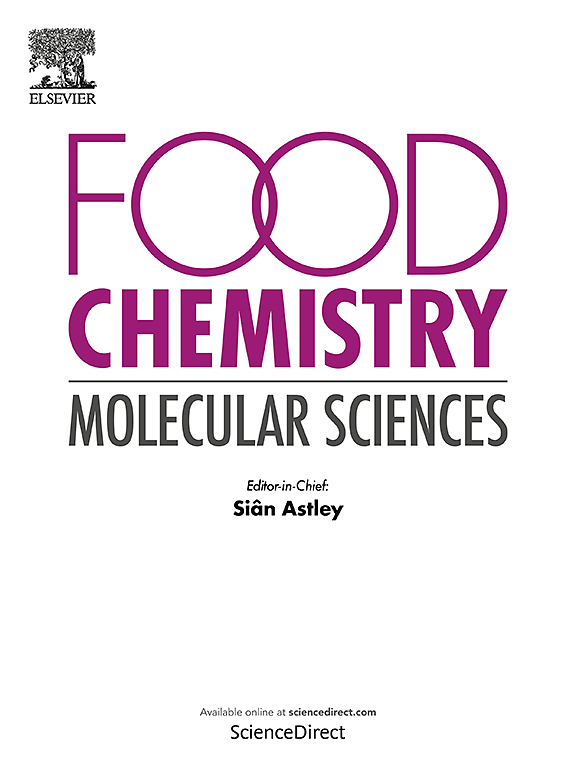香榧仁肽调节高脂肪饮食小鼠的脂质ii抑制剂
IF 4.1
Q2 FOOD SCIENCE & TECHNOLOGY
引用次数: 0
摘要
植物源性生物活性肽因其具有生物活性、成本低、安全、易于工业化生产等优点而日益受到营养和食品科学领域的关注。大香榧的功能肽因其作为膳食补充剂的潜力而受到研究。本研究的重点是在喂食高脂肪饮食的小鼠中调节脂质ii抑制剂的大核桃肽。蛋白质组分析鉴定了一种参与宿主防御的维西林样抗菌肽。16S rRNA测序显示,大梭菌给药后,肠道菌群发生改变,表现为Akkermansia和副芽孢杆菌数量增加,同时厚壁菌门数量减少。有益菌如Akkermansia改善了肠道功能,增加了短链脂肪酸(SCFAs)的水平。在高脂饮食的模型组中,添加大叶黄酮可降低小鼠体重、TC、TG、LDL,降低炎症,同时降低氧化应激,增加HDL。高肽组引起肝脏、肌肉和血管中的脂滴大幅减少。转录组分析强调通过PPAR-α途径进行脂质调节,分子对接揭示了4种潜在的脂质II抑制肽。这些研究结果表明,大核桃是一种很有前途的食品补充剂,也是一种重要的营养保健坚果。本文章由计算机程序翻译,如有差异,请以英文原文为准。

Torreya grandis nut peptides regulate lipid-II inhibitors in high-fat diet-fed mice
Plant-derived bioactive peptides have drawn increasing attention in the field of nutrition and food science due to their biological activities, low cost, safety, and ease of industrial production. Functional peptides from Torreya grandis are being investigated due to their potential as dietary supplements. This study focuses on T. grandis nut peptides that regulate LIPID-II inhibitor in mice fed a high-fat diet. Proteome analysis identified a Vicilin-like antimicrobial peptide involved in host defense. 16S rRNA Sequencing revealed alteration in gut microbiota with T. grandis administration as manifested by increased Akkermansia and Parabacteroides concurrently by decreased Firmicutes. Beneficial bacteria i.e., Akkermansia improved intestinal functions and increased levels of short chain fatty acids (SCFAs). T. grandis supplementation in HFD mice reduced body weight, TC, TG, LDL, and decreased inflammation, while reducing oxidative stress and increasing HDL in the model group fed a high-fat diet. Lipid droplets in liver, muscles, and blood vessels were highly reduced, evoked by the high peptide group. Transcriptome analysis highlighted lipid regulation via the PPAR-α pathway, with molecular docking revealing 4 potential lipid II inhibitory peptides. These findings suggested T. grandis as a promising supplement in food and a key nut for nutraceutical purposes.
求助全文
通过发布文献求助,成功后即可免费获取论文全文。
去求助
来源期刊

Food Chemistry Molecular Sciences
Agricultural and Biological Sciences-Food Science
CiteScore
6.00
自引率
0.00%
发文量
83
审稿时长
82 days
期刊介绍:
Food Chemistry: Molecular Sciences is one of three companion journals to the highly respected Food Chemistry.
Food Chemistry: Molecular Sciences is an open access journal publishing research advancing the theory and practice of molecular sciences of foods.
The types of articles considered are original research articles, analytical methods, comprehensive reviews and commentaries.
Topics include:
Molecular sciences relating to major and minor components of food (nutrients and bioactives) and their physiological, sensory, flavour, and microbiological aspects; data must be sufficient to demonstrate relevance to foods and as consumed by humans
Changes in molecular composition or structure in foods occurring or induced during growth, distribution and processing (industrial or domestic) or as a result of human metabolism
Quality, safety, authenticity and traceability of foods and packaging materials
Valorisation of food waste arising from processing and exploitation of by-products
Molecular sciences of additives, contaminants including agro-chemicals, together with their metabolism, food fate and benefit: risk to human health
Novel analytical and computational (bioinformatics) methods related to foods as consumed, nutrients and bioactives, sensory, metabolic fate, and origins of foods. Articles must be concerned with new or novel methods or novel uses and must be applied to real-world samples to demonstrate robustness. Those dealing with significant improvements to existing methods or foods and commodities from different regions, and re-use of existing data will be considered, provided authors can establish sufficient originality.
 求助内容:
求助内容: 应助结果提醒方式:
应助结果提醒方式:


